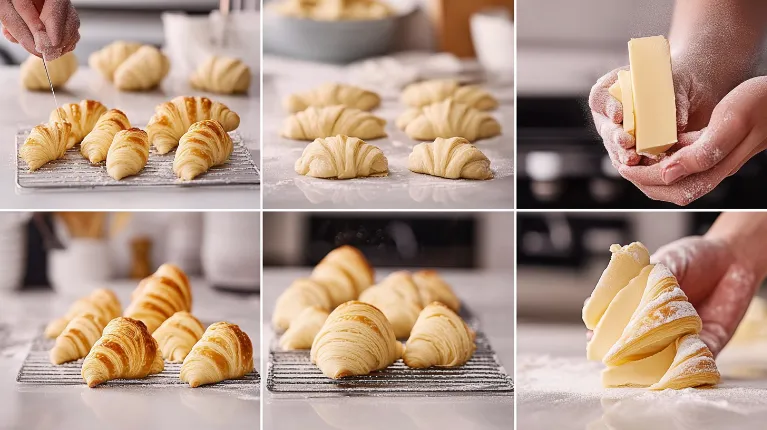Who doesn’t love a bite-sized croissant? Whether you’re hosting a brunch, craving a snack, or just love the buttery layers of this classic French pastry, mini croissants are here to save the day! These little wonders are everything you love about regular croissants—flaky, golden, and irresistibly tasty—just in a smaller, more manageable package. Plus, they’re perfect for entertaining or even just indulging solo.
But how did we get here? How did the humble croissant shrink down to mini perfection? And why are they so universally loved? Stick with me because this guide will take you through everything you need to know about mini croissants, from their history to how you can whip up a batch yourself at home.
History and Origin
Ah, the croissant—a pastry that’s as iconic as the Eiffel Tower itself! But did you know these buttery beauties didn’t actually start in France? That’s right. The croissant has its roots in Austria, with the kipferl, a crescent-shaped bread that dates back to the 13th century. The French added their flair to the recipe, introducing laminated dough to give croissants their signature layers.
Mini croissants came into the picture more recently, likely as a result of modern culinary trends emphasizing bite-sized convenience. These petite pastries have become a staple in bakeries worldwide, beloved for their versatility and charm. They’re proof that good things do come in small packages.
Cultural Significance
Mini croissants have carved their niche across cultures. In France, they’re a café staple. Across the Atlantic, Americans enjoy them as hors d’oeuvres or even as a quick breakfast. Their small size makes them adaptable—ideal for sweet or savory fillings. And who can resist something that looks as good as it tastes?
Evolution Over Time
As global cuisine embraced portability and convenience, mini croissants found their moment to shine. Today, you’ll find them everywhere—from the frozen aisle at Trader Joe’s to high-end patisseries. Their enduring popularity is a testament to their universal appeal.
Ingredients and Equipment
To make mini croissants, you don’t need a ton of fancy equipment—just patience and the right ingredients. Here’s everything you’ll need:
Ingredients Table
| Ingredient | Quantity | Substitution |
|---|---|---|
| All-purpose flour | 3 cups | Gluten-free flour blend |
| Unsalted butter | 1 cup | Vegan butter |
| Milk | 1 cup | Plant-based milk (like almond milk) |
| Active dry yeast | 1 packet | Instant yeast |
| Sugar | 2 tbsp | Honey or maple syrup |
| Salt | 1 tsp | Sea salt or kosher salt |

Required Equipment
- Rolling pin
- Pastry brush
- Baking sheet
- Parchment paper
- Dough scraper
Substitution Ideas
- For a dairy-free version, swap butter with coconut oil or vegan butter.
- Experiment with sweeteners like agave or brown sugar for a unique flavor.
The Art of Making Mini Croissants at Home
Making mini croissants at home might seem like a daunting task, but trust me, it’s totally doable—and dare I say, fun! Plus, there’s nothing like biting into a flaky, buttery pastry fresh from your own oven. Ready to roll (literally)? Let’s dive into the step-by-step guide to crafting these delicious bite-sized wonders.
Preparing the Dough
The dough is the heart and soul of your mini croissants. It’s all about getting those perfect layers that give croissants their signature flakiness.
Ingredients Check
Before starting, ensure you have all your ingredients prepped and measured. Trust me, this little step saves a lot of hassle later.
Step 1: Activating the Yeast
First, warm your milk until it’s just lukewarm—not hot, as that could kill the yeast. Sprinkle in the sugar and yeast, then give it a quick stir. Let it sit for about 5–10 minutes until it’s frothy. If it’s not bubbling, the yeast might be expired, and you’ll need a fresh batch.
Step 2: Mixing the Dough
Next, combine the flour, salt, and yeast mixture in a large bowl. Stir with a wooden spoon until it comes together. If the dough feels too sticky, sprinkle in a little extra flour. Knead it for about 8 minutes or until it’s smooth and elastic.
Laminating and Folding Techniques
This is where the magic happens. Laminating the dough creates the layers that make croissants irresistibly flaky.
Step 3: Preparing the Butter Block
Then, take your cold butter and place it between two sheets of parchment paper. Using a rolling pin, pound it into a flat, even rectangle about ½ inch thick. Chill it for a few minutes to keep it firm.
Step 4: Rolling and Folding
Next, roll out your dough into a rectangle that’s twice the size of your butter block. Place the butter block in the center, fold the dough over it like a letter, and seal the edges. Roll it out gently to ensure the butter spreads evenly.

Step 5: The “Turns”
Then comes the folding process. Roll out the dough, fold it into thirds, and chill it for 30 minutes. Repeat this process 3–4 times, chilling the dough between each turn. This step is crucial for creating those delicate layers.
Shaping and Baking Mini Croissants
Now for the fun part—shaping your mini croissants!
Step 6: Cutting the Dough
First, roll the dough into a large rectangle, about ¼ inch thick. Using a sharp knife or pizza cutter, divide it into long triangles. For mini croissants, make smaller triangles by cutting the dough crosswise.
Step 7: Shaping
Next, take a triangle, stretch the base gently, and roll it up toward the tip. Place the rolled croissants on a parchment-lined baking sheet, with the tip tucked underneath to hold the shape.
Step 8: Proofing
Let the croissants proof at room temperature for about 1–2 hours. They should double in size and look puffy. Don’t rush this step—proofing gives the dough its light, airy texture.
Step 9: Egg Wash
Brush each croissant with an egg wash made of beaten egg and a splash of milk. This gives them that golden, glossy finish when baked.
Step 10: Baking
Finally, bake your croissants in a preheated oven at 375°F (190°C) for 12–15 minutes or until golden brown. The smell wafting through your kitchen will be absolutely heavenly.
Helpful Tips for Success
- Chill the Dough: Keeping the dough cold is key. If it gets too warm, the butter will melt, ruining the layers.
- Work Quickly: When handling the dough, try to work fast to prevent the butter from softening.
- Test Your Yeast: Always proof your yeast to ensure it’s active—no one wants a dough that doesn’t rise.
Making mini croissants at home might take some time, but the results are so worth it. These little pastries are perfect for breakfast, snacks, or even fancy appetizers. And the best part? You made them all by yourself!
Let me know when you’re ready to move on to Part 4: Creative Variations of Mini Croissants. 😊
Tips for Perfect Mini Croissants and Troubleshooting
Making mini croissants is a rewarding process, but let’s face it—things don’t always go smoothly. Whether it’s dough that won’t rise or croissants that turn out dense instead of flaky, here are some tips to help you ace this recipe and tackle common challenges.
Perfecting Your Dough
The dough is the foundation of your mini croissants. A well-prepped dough ensures the buttery layers turn out light and airy.
Tip 1: Keep Everything Cold
Butter is the star ingredient, and keeping it cold is essential. Warm butter can melt into the dough, ruining the layers. However, if your kitchen is warm, chill the dough between each step to keep things cool.
Tip 2: Use Quality Ingredients
On the other hand, skimping on good butter or flour can affect the final taste and texture. Always use high-quality ingredients to get bakery-worthy results.
Troubleshooting Common Issues
Problem: Croissants Are Too Dense
If your mini croissants come out dense, the dough may not have proofed long enough. Ensure your yeast is active and allow the dough ample time to rise.
Problem: Butter Leaks Out
Butter leaking during baking usually happens when the dough isn’t sealed properly. Be sure to tuck the edges tightly when folding and shaping.
Problem: Dough Is Sticky
Sticky dough can make the rolling and folding process tricky. Sprinkle your surface lightly with flour to prevent sticking, but don’t overdo it—too much flour can make the croissants dry.
Serving and Garnishing Mini Croissants
Once you’ve baked your mini croissants, it’s time to show them off. Presentation can make a big difference, especially if you’re serving these at a party or special brunch.
Creative Plating Ideas
- Sweet Croissants: Dust them with powdered sugar or drizzle with melted chocolate. Pair them with a small plate of fresh berries for a pop of color.
- Savory Croissants: Arrange them on a platter with dips like hummus, spinach dip, or garlic aioli. Fresh herbs, such as parsley or chives, make a perfect garnish.
Side Dish Pairings
- Pair sweet mini croissants with fresh fruit salads or yogurt parfaits for a refreshing breakfast option.
- For savory croissants, serve with scrambled eggs, smoked salmon, or even a bowl of creamy soup for a cozy meal.
Nothing says “brunch goals” like a plate of fresh, buttery mini croissants. Pair these delightful pastries with a vibrant side, such as the Mexican Creamer in Scrambled Eggs. The creamy, spicy twist on classic scrambled eggs perfectly complements the flaky texture of the croissants, creating a memorable meal that’s sure to impress your guests.
Serving mini croissants isn’t just about the taste—it’s also about creating an experience. Add a little flair with thoughtful garnishes and pairings, and watch your guests (or family) devour them with joy.
Ready to get creative? Let me know when you’re prepared to explore additional ideas or discuss FAQs about mini croissants! 😊
Healthier Alternatives and Dietary Considerations
Who says indulgence and health can’t go hand in hand? With a few clever swaps, mini croissants can fit into various dietary needs without compromising on taste. Whether you’re watching your calories, avoiding gluten, or embracing veganism, there’s a variation for you.
Healthier Ingredient Swaps
Swap 1: Whole Wheat Flour
For a fiber-rich option, replace all-purpose flour with whole wheat flour. It adds a nutty flavor and boosts the nutritional profile.
Swap 2: Plant-Based Butter
For vegans or those cutting back on dairy, plant-based butter works like a charm. Brands like Miyoko’s or Earth Balance provide great alternatives.
Swap 3: Natural Sweeteners
Instead of sugar, try honey, agave, or maple syrup. They provide a subtle sweetness while being less processed.
Dietary-Specific Variations
- Gluten-Free Option: Use a gluten-free flour blend specifically designed for baking. Additionally, ensure your workspace and tools are gluten-free to avoid cross-contamination.
- Low-Fat Version: Reduce the butter slightly or use a light margarine. The croissants may be a little less flaky, but they’ll still be delicious.
Storing, Reheating, and Pairing Beverages
Baked too many mini croissants to enjoy in one sitting? No worries. With proper storage and reheating techniques, you can savor them later without losing their delightful taste and texture.
Storing Leftovers
- At Room Temperature: Store croissants in an airtight container for up to 2 days. Adding a piece of parchment paper prevents sticking.
- In the Fridge: Place croissants in a sealed bag or container to keep them fresh for 4–5 days.
- Freezing: Freeze uncooked croissants on a baking sheet, then transfer them to a freezer bag. They’ll stay good for up to 3 months.
Reheating Tips
- Oven: Preheat to 350°F (175°C). Warm croissants for 5–7 minutes for that freshly baked feel.
- Microwave: Use medium power for 10–15 seconds. However, note that they may lose some of their crispness.
Pairing Beverages
Pairing the perfect drink with your mini croissants can elevate the experience.
- Sweet Croissants: Pair with a hot cup of coffee, cappuccino, or spiced chai latte. For a refreshing twist, try iced tea.
- Savory Croissants: Enjoy with sparkling water, a crisp white wine (if indulging), or even a hearty tomato juice.
Looking for a sweet treat to accompany your mini croissants? Round out your table with a batch of Strawberry Cream Cheese Pastries with Streusel. The creamy filling and crumbly topping pair beautifully with the flaky layers of croissants, making this combo a crowd-pleaser.
These tips ensure your mini croissants remain as delightful as the moment they left the oven. Whether stored for later or paired with your favorite beverage, they’re guaranteed to keep your taste buds happy.
Frequently Asked Questions About Mini Croissants
Curious about mini croissants? You’re not alone! Here are some common questions people have about these delightful pastries, along with helpful answers.
What is a Small Croissant Called?
A small croissant is often referred to as a mini croissant or petit croissant. These bite-sized versions of the classic pastry are popular for their convenience and versatility, making them a staple in brunch spreads and café menus.
How to Make Trader Joe’s Mini Croissants?
Trader Joe’s mini croissants are known for their flaky, buttery goodness. To prepare them, simply thaw the pre-made dough overnight, let them proof at room temperature until they double in size, and bake in a preheated oven at 375°F (190°C) for about 15 minutes. They come out golden, crisp, and ready to enjoy.
Are Mini Croissants Healthy?
While mini croissants are undeniably delicious, they’re a treat best enjoyed in moderation. However, by using whole wheat flour, reducing butter, or adding nutrient-dense fillings like spinach or berries, you can make them a bit healthier. For example, substituting regular butter with plant-based options lowers the saturated fat content.
How Do You Cut Mini Croissants?
To cut mini croissants, first roll out your dough into a large rectangle. Then, use a sharp knife or pizza cutter to divide it into long triangles. For mini croissants, ensure the triangles are smaller, with a width of about 3–4 inches at the base. This creates the perfect size for bite-sized pastries.
Conclusion and Final Thoughts
And there you have it—everything you need to know about making and enjoying mini croissants! From their rich history to crafting them at home and even serving them with flair, these petite pastries are as versatile as they are irresistible.
Whether you’re baking them for a special occasion or just to treat yourself, mini croissants are a surefire way to impress. Plus, with healthier alternatives and creative variations, there’s something for everyone to love.
What’s Next?
If you’re inspired to bake, gather your ingredients and get rolling! Don’t forget to experiment with different fillings or toppings to make the recipe your own. Share your creations with friends and family, or tag us on social media—we’d love to see your results.
Related Recipe: Don’t miss our Bite-Sized Pastry Ideas for even more fun treats to try.
So, what are you waiting for? Get baking and enjoy the buttery, flaky goodness of mini croissants today! 😊
Table of Contents

The Ultimate Guide to Mini Croissants
- Total Time: 2 hours 15 minutes
- Yield: 12 mini croissants 1x
- Diet: Vegetarian
Description
Write a brief, enticing description of the recipe. For example: “Learn how to make buttery, flaky mini croissants from scratch with this easy guide. Perfect for brunches, snacks, or special occasions, these bite-sized pastries are sure to impress!”
Ingredients
Use a bulleted format for clarity. For example:
- 3 cups all-purpose flour (or gluten-free flour blend)
- 1 cup unsalted butter (or plant-based butter)
- 1 cup milk (or almond milk)
- 1 packet active dry yeast
- 2 tablespoons sugar
- 1 teaspoon salt
Instructions
Provide a clear, step-by-step guide. Here’s an example:
- Activate the Yeast: Warm the milk until lukewarm, then mix with sugar and yeast. Let it sit for 5–10 minutes until frothy.
- Mix the Dough: Combine the flour, salt, and yeast mixture. Knead until smooth and elastic. Cover and let it rest for 1 hour.
- Prepare the Butter Block: Flatten the butter between parchment paper into a rectangle and chill.
- Roll and Fold: Roll the dough into a large rectangle, place the butter block in the center, and fold the dough over it. Roll gently and repeat the folding process 3–4 times, chilling between folds.
- Cut and Shape: Roll out the dough, cut into small triangles, and roll each into a mini croissant shape.
- Proof: Let the croissants proof for 1–2 hours at room temperature.
- Bake: Brush with egg wash and bake at 375°F (190°C) for 12–15 minutes until golden brown.
Notes
Add helpful tips or substitutions for the recipe. For example:
- Substitute regular flour with a gluten-free blend for dietary needs.
- Keep the dough cold throughout the process to maintain the flaky layers.
- Freeze unbaked croissants for up to 3 months and bake fresh as needed.
- Prep Time: 2 hours (including proofing time)
- Cook Time: 15 minutes
- Category: Pastries
- Method: Baking
- Cuisine: French
Nutrition
- Serving Size: 1 mini croissant
- Calories: 120 kcal
- Sugar: 2 g
- Fat: 8 g
- Protein: 2 g
Keywords: mini croissants, small croissants, petit croissants, bite-sized pastries, mini pastry recipe




